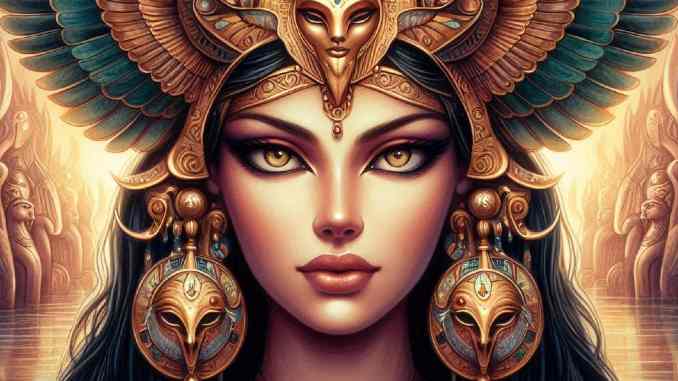
Hathor the Egyptian Goddess of Femininity and Harmony
Hathor, one of the oldest and most significant goddesses of ancient Egypt, embodies the power of femininity in its purest and most multifaceted form. She is revered as the goddess of love, fertility, joy, and music, symbolizing the harmony between body, mind, and soul. Hathor is a central figure representing the importance of the feminine in creation and in human life. This article delves into the history and symbolic meaning of Hathor and reveals why she remains a source of strength and inspiration in the spiritual world today.
The History and Origins of Hathor
Hathor’s origins trace back to ancient Egypt, where she has been worshiped as a protective and maternal goddess for millennia. Her reverence dates back to Egypt’s Early Dynastic Period (around 3000 BCE) and continued over many centuries. Hathor, whose name means “House of Horus,” is seen as the mother or consort of the sky god Horus, linking her closely to the royal family and the idea of divine protection.
- Symbol of Royal Power: Egyptian pharaohs regarded themselves as children of Hathor, honoring her as the goddess who protects and supports the rule and lives of kings.
- Fertility and Cosmic Order: As the goddess of fertility and the life cycle, Hathor held a central role in Egyptian religion. She embodied cosmic order and balance between the earthly and the divine, which explains the reverence for her aspects as a giver of life, as well as a goddess of renewal and resurrection.
The Mythological Significance of Hathor: Female Power and Life
Hathor is worshiped as the goddess of love, happiness, and music, representing joy and abundance in life. Her mythology encompasses several dimensions:
- Goddess of Love and Sexuality: Hathor is a symbol of beauty, love, and sexual attraction. She inspires and strengthens feminine power, enabling people to experience love and passion in harmony with the universe.
- Protector of Women and Mothers: Hathor, as a goddess of protection, especially stands beside women, promoting the feminine principles of care, protection, and maternal love. She is often invoked by women seeking support in motherhood and fertility.
- Goddess of Joy and Festivities: Known as the goddess of music, dance, and celebration, Hathor is connected to all things that bring joy and lightness. She teaches people to embrace life and connect with the pleasures of existence.
Hathor and Her Symbols: The Cult and Symbols of the Goddess
Hathor is often depicted as a woman with cow horns framing a sun disk, symbolizing her connection to fertility, abundance, and the divine sun. In Egyptian mythology, Hathor represents the forces of nature and the sun, which gives and sustains life.
- Cow Horns and Sun Disk: The horns and sun disk symbolize Hathor’s fertility and her connection to the sun as the source of life. These symbols portray Hathor as a provider who both nourishes and protects.
- Sistrum (Rattle Instrument): The sistrum, a sacred musical instrument associated with Hathor, symbolizes joy, music, and the rhythm of life. It was played in rituals dedicated to Hathor to invoke positive energies and prosperity.
- Mirror and Beauty: Hathor is often depicted with a mirror, symbolizing beauty and the recognition of one’s own essence. The mirror represents self-awareness and the recognition of inner beauty, a quality that Hathor, as the goddess of femininity, imparts.
Hathor as a Goddess of Spiritual Growth and Inner Harmony

For spiritually inclined individuals, Hathor is not merely a historical goddess but an inspiration for spiritual growth and inner harmony. She teaches us to celebrate life, find joy, and connect with our inner strength.
- Self-Love and Acceptance: Hathor reminds us to value and nurture our feminine aspects – love, compassion, and intuition. She stands for self-love and inner acceptance, helping us connect with our essence and live authentically.
- Encouragement of Creativity: Connecting with Hathor can unleash creative energy. She promotes artistic expression and encourages finding a soulful outlet through music, dance, and art.
- Balance of Mind and Body: Hathor symbolizes harmony between body, mind, and soul. Her energy supports us in finding balance across all areas of life and finding our own center. This harmonious state lays the foundation for spiritual growth and the experience of inner strength.
Rituals and Worship of Hathor in Modern Spirituality
Today, Hathor continues to inspire many spiritually inclined individuals who seek to foster their feminine power and spiritual balance. Through rituals, meditations, and affirmations, one can activate Hathor’s energy and invite her as a guide on their spiritual journey.
- Meditation for Self-Love: In meditation, imagine yourself surrounded by Hathor’s warm, golden light. Feel her energy filling your heart, igniting a deep sense of love and appreciation for yourself.
- Creative Rituals: Celebrate Hathor’s energy through music, dance, or painting. Express yourself through artistic activities that bring you joy and allow the goddess to work through your creative flow.
- Affirmations and Prayers: Speak affirmations like “I am filled with love and joy” or “I honor the goddess within me.” Such affirmations strengthen the connection to Hathor and promote self-love and inner harmony.
Conclusion: Hathor as a Timeless Goddess and Source of Feminine Power
Hathor is a goddess of love, beauty, joy, and inner harmony. Her energy reminds us to celebrate life and to recognize the divine within. Especially for spiritually oriented individuals, Hathor is a symbol of self-love, creativity, and the harmonious balance of body, mind, and soul.
By connecting with Hathor, we can strengthen our femininity, invite inner peace, and bring joy into our lives. She teaches us that the power of the feminine is a profound source of healing and well-being – a reminder that is of inestimable value even in modern times.
13. Oktober 2024
Uwe Taschow
Alle Beiträge des Autors auf Spirit OnlineAs a writer, I think about life. My own stories tell me who I am, but also who I can be. I wring insights from life in order to shape, to recognize truths that are worth writing for. That’s one of the reasons why I work as co-editor of the online magazine Spirit Online.





